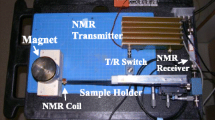Abstract
Biofilm and dairy fouling formation is difficult to study non-invasively in closed systems such as flexible tubing. Nuclear magnetic resonance (NMR) is considered as a promising non-invasive detection method for different deposits. This study aimed to investigate three deposit models: (1) Paenibacillus polymyxa biofilm, (2) dairy biofouling, and (3) dairy fouling, in different experimental set-ups by low-field 1H NMR. The transverse relaxation time T2 of each component in samples of experimental set-ups was studied. The results show that low-field NMR offers the possibility of qualitatively measuring the selected deposit models and differentiating non-destructively between the tubing and each deposit. The samples in each experimental set-up showed characteristic relaxation behavior of flexible tubing, deposit, and liquid. For the P. polymyxa biofilm, longer relaxation times T2 of about 100 ms were detected, while relaxation times T2 for dairy biofouling and dairy fouling were in range of 50–60 ms. It was thus concluded that low-field NMR has a great potential for non-invasive detection of deposit formation at practical industrial scales.






Similar content being viewed by others
References
Cappitelli F, Polo A, Villa F (2014) Biofilm formation in food processing environments is still poorly understood and controlled. Food Eng Rev 6(1–2):29–42
Srey S, Jahid IK, Ha S-D (2013) Biofilm formation in food industries: a food safety concern. Food Control 31(2):572–585
Derlon N, Gruetter A, Brandenberger F, Sutter A, Kuhlicke U, Neu TR, Morgenroth E (2016) The composition and compression of biofilms developed on ultrafiltration membranes determine hydraulic biofilm resistance. Water Res 102:63–72
Marchand S, De Block J, De Jonghe V, Coorevits A, Heyndrickx M, Herman L (2012) Biofilm formation in milk production and processing environments: influence on milk quality and safety. Compr Rev Food Sci Food Saf 11(2):133–147
Lewandowski Z, Beyenal H (2013) Fundamentals of biofilm research, 2nd edn
Flemming H-C (2002) Biofouling in water systems—cases, causes and countermeasures. Appl Microbiol Biotechnol 59(6):629–640
Kessler HG (2006) Lebensmittel- und Bioverfahrenstechnik: Molkereitechnologie, 4th edn
Grady EN, MacDonald J, Liu L, Richman A, Yuan Z-C (2016) Current knowledge and perspectives of Paenibacillus: a review. Microb Cell Fact 15:203
De Jonghe V, Coorevits A, De Block J, Van Coillie E, Grijspeerdt K, Herman L, De Vos P, Heyndrickx M (2010) Toxinogenic and spoilage potential of aerobic spore-formers isolated from raw milk. Int J Food Microbiol 136(3):318–325
Kim YW, Sardari SE, Meyer MT, Iliadis AA, Wu HC, Bentley WE, Ghodssi R (2012) An ALD aluminum oxide passivated Surface Acoustic Wave sensor for early biofilm detection. Sens Actuators B Chem 163(1):136–145
Kang J, Kim T, Tak Y, Lee J-H, Yoon J (2012) Cyclic voltammetry for monitoring bacterial attachment and biofilm formation. J Ind Eng Chem 18(2):800–807
Crattelet J, Ghnimi S, Debreyne P, Zaid I, Boukabache A, Esteve D, Auret L, Fillaudeau L (2013) On-line local thermal pulse analysis sensor to monitor fouling and cleaning: application to dairy product pasteurisation with an ohmic cell jet heater. J Food Eng 119(1):72–83
Fridjonsson EO, Vogt SJ, Vrouwenvelder JS, Johns ML (2015) Early non-destructive biofouling detection in spiral wound RO membranes using a mobile earth׳s field NMR. J Membr Sci 489:227–236
Vogt M, Flemming H-C, Veeman WS (2000) Diffusion in Pseudomonas aeruginosa biofilms: a pulsed field gradient NMR study. J Biotechnol 77(1):137–146
Sanderlin AB, Vogt SJ, Grunewald E, Bergin BA, Codd SL (2013) Biofilm detection in natural unconsolidated porous media using a low-field magnetic resonance system. Environ Sci Technol 47(2):987–992
Hoskins BC, Fevang L, Majors PD, Sharma MM, Georgiou G (1999) Selective imaging of biofilms in porous media by NMR relaxation. J Magn Reson 139(1):67–73
Marcone MF, Wang S, Albabish W, Nie S, Somnarain D, Hill A (2003) Diverse food-based applications of nuclear magnetic resonance (NMR) technology. Food Res Int 51(2):729–747
Belloque J, Ramos M (1999) Application of NMR spectroscopy to milk and dairy products. Trends Food Sci Technol 10(10):313–320
Kirkland CM, Herrling MP, Hiebert R, Bender AT, Grunewald E, Walsh DO, Codd SL (2015) In situ detection of subsurface biofilm using low-field NMR: a field study. Environ Sci Technol 49(18):11045–11052
Kirkland CM, Hiebert R, Phillips A, Grunewald E, Walsh DO, Seymour JD, Codd SL (2015) Biofilm detection in a model well-bore environment using low-field NMR. Groundw Monit Remediat 35(4):36–44
Manz B, Volke F, Goll D, Horn H (2003) Measuring local flow velocities and biofilm structure in biofilm systems with magnetic resonance imaging (MRI). Biotechnol Bioeng 84(4):424–432
rilt Regularized Inverse Laplace Transform (2007) 1.0.0.0 (4.39 KB) by Iari-Gabriel Marino, in. https://de.mathworks.com/matlabcentral/fileexchange/6523-rilt
Belton PS (1997) NMR and the mobility of water in polysaccharide gels. Int J Biol Macromol 21(1–2):81–88
Garny K, Neu TR, Horn H, Volke F, Manz B (2010) Combined application of 13C NMR spectroscopy and confocal laser scanning microscopy—investigation on biofilm structure and physico-chemical properties. Chem Eng Sci 65(16):4691–4700
Simões M, Simões LC, Vieira MJ (2010) A review of current and emergent biofilm control strategies. LWT Food Sci Technol 43(4):573–583
Funding
This research did not receive any specific grant from funding agencies in the public, commercial, or not-for-profit sectors.
Author information
Authors and Affiliations
Corresponding author
Ethics declarations
Conflict of interest
The authors declare that they have no conflict of interest.
Compliance with ethics requirements
This article does not contain any studies with human or animal subjects.
Additional information
Publisher's Note
Springer Nature remains neutral with regard to jurisdictional claims in published maps and institutional affiliations.
Rights and permissions
About this article
Cite this article
Fysun, O., Anzmann, T., Gschwind, P. et al. Biofilm and dairy fouling detection in flexible tubing using low-field NMR. Eur Food Res Technol 245, 2579–2590 (2019). https://doi.org/10.1007/s00217-019-03371-4
Received:
Accepted:
Published:
Issue Date:
DOI: https://doi.org/10.1007/s00217-019-03371-4




